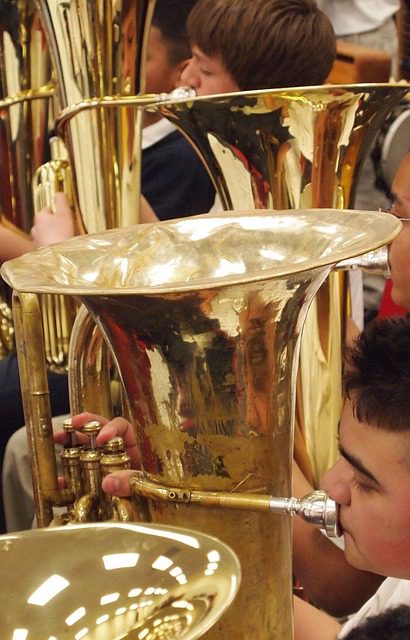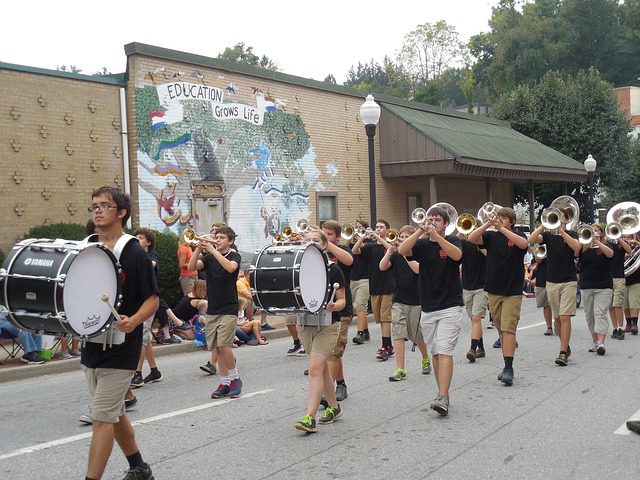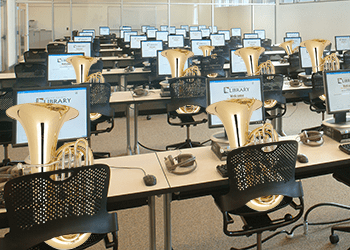The Bandwidth Bandwagon
Bandwidth? Isn’t that how many band members you can get side by side across the street? Well, It can be, but not at the library.
 What does it have to do with your library? Well, let’s take a look!
What does it have to do with your library? Well, let’s take a look!
First, picture in your head a band marching down a typical street, and there’s all kind of instruments from the tiny piccolo to the big bad tuba.
Generally they march with all of the same kinds of horns/instruments in the same row, right? And at the front where the piccolo is there are quite a few members marching in each line. At the back where the tubas are there are fewer members. Bigger horn = more space. More space = fewer marchers in the same line. Why? Smaller horns take less space so the marchers can stand closer together and you can have more of them in a row.
Cool picture huh? Yeah, me too. OOompaHH OooMPAh OOOmmPAH
 Now, just for fun, let’s say we combine the tuba and the piccolo players in one line. Crazy I know, but this is where we start to make sense of bandwidth at the library. You see, when we add too many band members, others are pushed back or forward and the street starts to get crowded. Then players have a tough time playing their tuba or piccolo.
Now, just for fun, let’s say we combine the tuba and the piccolo players in one line. Crazy I know, but this is where we start to make sense of bandwidth at the library. You see, when we add too many band members, others are pushed back or forward and the street starts to get crowded. Then players have a tough time playing their tuba or piccolo.
That’s what can happen at the library when you bring your wireless device and jump on our “bandwidth wagon.” Every day we have many users who bring a laptop, tablet, or smartphone to the library and connect to our super-great, free wireless network. Some folks bring all 3 devices!
And, just like the street, crowded with too many band members, we often have many users at the same time competing for bandwidth with their device. This kind of bandwidth, however, is the capacity of our network to serve all the requests for data/information/movies/music/games/you name it.
 Many are carrying tubas (watching videos on Youtube and other sources, or online games) while some have trumpets (checking email or doing basic research) and some have piccolos (weather updates, snapchatterers and the like). The more tuba players we have the less bandwidth available for others.
Many are carrying tubas (watching videos on Youtube and other sources, or online games) while some have trumpets (checking email or doing basic research) and some have piccolos (weather updates, snapchatterers and the like). The more tuba players we have the less bandwidth available for others.
So, how do we try to keep this equitable? We put a limit on how much bandwidth each connection can take. Each connection has a “speed limit,” if you will, of 1Mbps. That way if we have 4 connections trying to download a large operating system, it limits their speed so others can continue to work. Otherwise, if there were no limits, one tuba might get all the sound, and the next one not be heard by anyone.
 In January 2016 we had, on average, 156 users connect per day. The average session time for each user was 3 hours. That means, in an 11-hour day, we had 468 hours of wireless internet connectivity. That’s an average of 42 connections per hour.
In January 2016 we had, on average, 156 users connect per day. The average session time for each user was 3 hours. That means, in an 11-hour day, we had 468 hours of wireless internet connectivity. That’s an average of 42 connections per hour.
Imagine if they were all trying to play tubas! And you thought the library was a quiet place…
So, if you’re wondering why we don’t have the fastest connection in town, it’s because we’re trying to make sure each member of the band has some street they can march in. Now, go grab your horn and come join the band.
~Court
